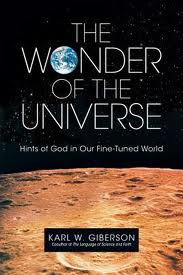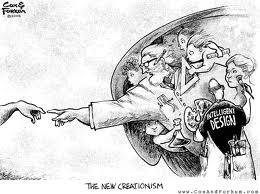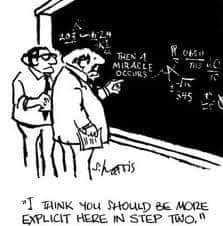 Today, Karl Giberson continues his six-part series of excerpts from his new book The Wonder of the Universe: Hints of God in a Fine-Tuned World . Karl Giberson, noted speaker and writer about the intersection of Christian faith and science. (See first post for intro; see his complete bio here.)
Today, Karl Giberson continues his six-part series of excerpts from his new book The Wonder of the Universe: Hints of God in a Fine-Tuned World . Karl Giberson, noted speaker and writer about the intersection of Christian faith and science. (See first post for intro; see his complete bio here.)
In this fifth excerpt, Giberson tells us that arguing for God based on the “design” of the universe is a bad idea.
Excerpt #5: Be Cautious with Design Arguments
Design arguments have been around forever and expressed in various ways. Most of them fall into what we call natural theology, which is the process of inferring something about the existence and nature of God by the inspection of nature.
The story of creation in Genesis launches the discussion in the Judeo-Christian tradition when it speaks of God ordering nature and driving back chaos. On the fourth day “God created the sun, moon, and the stars to give light to the earth and to govern and separate the day and the night. These would also serve as signs to mark seasons, days, and years.” All this suggests design and purpose. Job speaks of God making “water drops evaporate” so the clouds can “shower abundantly on mankind.” (Job 36:27-28 HCSB). The psalmist expresses awe at the grandeur of the night sky but remarkably does not comment on the grandeur of his own existence:
(Job 36:27-28 HCSB). The psalmist expresses awe at the grandeur of the night sky but remarkably does not comment on the grandeur of his own existence:
When I observe Your heavens,
the work of Your fingers, . . .
what is man that You remember him? (Psalm 8:3-4 HCSB)
In the New Testament, Paul speaks of the created order testifying clearly to the reality of God, arguing that “the invisible things of [God] from the creation of the world are clearly seen, being understood by the things that are made” (Romans 1:20 KJV). Biblical scholars have interpreted this to mean that an open-minded seeker can infer the existence of God by studying the creation.
As theologians reflected on the nature of the creation these arguments were repeated and refined. Augustine in the fourth century, Thomas Aquinas in the thirteenth century, Luther and Calvin at the time of the Reformation in the sixteenth century—all were understandably convinced that the world had a grand design that was readily discernable. After all, nobody had any other explanation for why birds were adapted to fly, fish to swim and constellations to mark the seasons.
By the time we get to Isaac Newton in the latter part of the seventeenth century, we have the first carefully constructed scientific arguments. Newton, as we learned in high school,explained how gravity from the sun keeps the planets in their orbits. This explanation replaced previous medieval explanations that included the possibility that the planets moved because angels pushed on them. (It also replaced Galileo’s explanation that they moved because of a “circular inertia,” which turned out to be as much a fantasy as the pushing angels.) But Newton’s theory didn’t explain why the planets all go around the sun in the same direction and in almost the same plane. In fact Newton could not imagine any natural process that could produce such elegant design, so he argued that God must be the explanation.
 About two centuries later the most famous design argument was developed by William Paley whose Natural Theology Darwin read voraciously as a young scientist. “Suppose I had found a watch upon the ground,” asked Paley, “and it should be inquired how the watch happened to be in that place. . . . [W]hen we come to inspect the watch, we perceive . . . that its several parts are framed and put together for a purpose. . . . [T]he inference, we think, is inevitable, that the watch must have had a maker.” Paley goes on to compare the watch to an eye, arguing that if a watch implies a watchmaker, then an eye implies an eye-maker. The eye-maker, of course, can only be God.
About two centuries later the most famous design argument was developed by William Paley whose Natural Theology Darwin read voraciously as a young scientist. “Suppose I had found a watch upon the ground,” asked Paley, “and it should be inquired how the watch happened to be in that place. . . . [W]hen we come to inspect the watch, we perceive . . . that its several parts are framed and put together for a purpose. . . . [T]he inference, we think, is inevitable, that the watch must have had a maker.” Paley goes on to compare the watch to an eye, arguing that if a watch implies a watchmaker, then an eye implies an eye-maker. The eye-maker, of course, can only be God.
Newton’s argument about the planets and Paley’s about the watch have the same logical form: We find something in nature that appears too ingeniously arranged to have been produced by known natural processes, so we infer that a Designer from outside the natural order—God— must be the source of the design.
Their arguments differ, however, on the question of purpose. It was not clear to Newton or anyone of his day exactly why the planets needed to be going about in the orderly way they were observed. If the order was indeed provided by God, no explanation for it could be discerned other than the creation of order for the sake of order. In contrast, the designs that Paley highlighted were clearly purposeful. Our eye is remarkably designed for a purpose other than to elicit awe at its complexity. We see with our eyes. We don’t do anything with Neptune’s nice orbit, other than admire it.
Arguments that the universe is designed are complicated. We certainly live in a remarkable universe with many features that inspire awe. Many of those features connect in astonishing ways to the habitability of the universe. The psalmist’s wonder at the heavens has only grown stronger as we have learned more about those heavens. The universe certainly does not become ever more boring and bland as we come to understand it.
But we also live in a world with earthquakes, plagues and tsunamis.
Our sun will burn out at some point, incinerating the earth in the process. The prospects of securing our future by colonizing other planets seem remote. The long-term prognosis of the universe, by the cold logical lights of science, is not good. Its temperature will continuously drop as it expands for billions of years. Eventually there won’t be enough heat left for any form of life, and finally there won’t even be enough heat for atoms and molecules to interact. This sterile icy blackness is frightening to contemplate. No matter what we do as a species, we and our cultural achievements are destined to perish.
colonizing other planets seem remote. The long-term prognosis of the universe, by the cold logical lights of science, is not good. Its temperature will continuously drop as it expands for billions of years. Eventually there won’t be enough heat left for any form of life, and finally there won’t even be enough heat for atoms and molecules to interact. This sterile icy blackness is frightening to contemplate. No matter what we do as a species, we and our cultural achievements are destined to perish.
No simple overriding explanation that makes sense of everything comes into view as we learn more about the universe.
And experience with past arguments raises red caution flags. For example, Newton’s design argument about the planets was an argument from ignorance that now bears the label “god of the gaps.” There was a gap in Newton’s explanation for the planets. He could explain why their orbits were elliptical and what kept them in their orbits. But he could not explain the uniformity of their orbits, so he invoked God as the explanation to plug this gap—hence the label for such arguments—god of the gaps.
 A century after Newton, French physicist Pierre Simon de Laplace dispelled the mystery of the structure of the solar system. He showed that a better understanding of gravity and how solar systems originated could explain the things that Newton attributed to the direct action of God. Laplace’s work did not refute the existence of God, of course. But it did dismantle Newton’s argument that the planetary orbits must have been set up by God, thus eliminating an argument that some had been using to argue for God’s existence.
A century after Newton, French physicist Pierre Simon de Laplace dispelled the mystery of the structure of the solar system. He showed that a better understanding of gravity and how solar systems originated could explain the things that Newton attributed to the direct action of God. Laplace’s work did not refute the existence of God, of course. But it did dismantle Newton’s argument that the planetary orbits must have been set up by God, thus eliminating an argument that some had been using to argue for God’s existence.
In a similar way, Darwin’s theory of evolution offers an explanation for the design that Paley marveled at in the eye. Scholars of Paley’s generation knew nothing of natural selection, mutations or genetics, so they could not imagine how nature might craft something so remarkable as an eye. Paley’s argument, like Newton’s, turns out to be another god of the gaps explanation that disappears with further scientific insights into the way the world works.
So this is the first red flag to note—design arguments are all-too-often based on gaps in our knowledge and will disappear when those gaps are filled.
The second red flag concerns the apparent purpose of any design.
“Design” can point in many directions or no direction at all.
The science museum in Boston has a grand contraption that does nothing except move balls around to no end. The only possible purpose is to impress a visitor with the juxtaposition of complex design and lack of purpose. There is likewise no significance to the patterns of the stars that we call constellations. The “design” of the Big Dipper is simply interesting.
The fine-tuning of the universe for life, on the other hand, encourages us to wonder if life may be important in some way. But it does not specify which life forms are relevant and why. And we must note that some features of our world exhibiting a high level of design—like the AIDS virus or the poison of the rattlesnake—seem to have the purpose to destroy human life. If rattlesnakes could reflect on their existence, they could marvel at the carbon resonance that makes that existence possible.
A third red flag we must note is bad design. If marvelous design in the universe motivates reflection on the possibility that God created the world what do we do about the counterarguments?
Consider asteroids. A gigantic asteroid struck the Yucatan Peninsula 65 million years ago and so disrupted the ecosystems and the atmosphere of the earth that the dinosaurs went extinct. Absolutely nothing prevents the same thing from happening again. We are protected today largely by the vastness of space and the structure of our solar system with large outer planets that “vacuum up” a lot of stuff that could hit the earth. These various protections make collisions of the sort that wiped out the dinosaurs unlikely. But they offer no guarantees.
If the Goldilocks features of our universe are intended to make it habitable, then why does the universe also have anti-Goldilocks features?
Many such issues complicate the process of figuring out why the universe is the way it is. And as we have learned somewhat reluctantly in the last few centuries, the great explanatory power of science disappears entirely when questions of purpose enter the conversation. Science is quite extraordinary at telling us how the world is but quite unable to tell us why the world is like that. Science illuminates the remarkable features of our universe that make life possible, but it goes silent when we ask whether any particular life form is the reason why the universe is the way it is. That deeply religious question has to be explored somewhere else.
somewhat reluctantly in the last few centuries, the great explanatory power of science disappears entirely when questions of purpose enter the conversation. Science is quite extraordinary at telling us how the world is but quite unable to tell us why the world is like that. Science illuminates the remarkable features of our universe that make life possible, but it goes silent when we ask whether any particular life form is the reason why the universe is the way it is. That deeply religious question has to be explored somewhere else.
These challenges caution us against naively selecting—cherry-picking we call it—a few Goldilocks features of the universe, assuming the friendly design work is for our benefit, and jumping to the conclusion that everything points simply and unambiguously in the direction of God as Creator.
